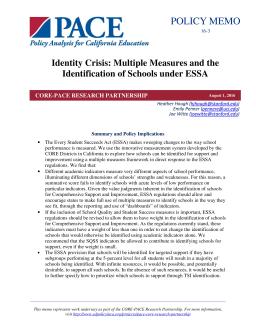Multiple measures and the identification of schools under ESSA
Published
Summary
This report examines the Every Student Succeeds Act (ESSA) and how schools can be identified for support and improvement using a multiple measures framework. The authors find that different academic indicators measure different aspects of school performance and suggest that states should be allowed to use multiple measures instead of a summative rating. They also find that non-academic indicators are not given enough weight and suggest a clarification in federal policy.
Comparing Different Student Subgroup Sizes for Accountability
Published
Summary
This policy brief analyzes the implications of using various subgroup sizes for school-level reporting under the ESSA. Data from the CORE Districts shows that a subgroup size of 20+ offers clear advantages in representing historically underserved student populations. The authors also produced a supplementary report comparing subgroup sizes of 20+ and 30+ in response to new ESSA regulations.
Published
Summary
To support policymaker discussions on including chronic absenteeism data in California's accountability system, PACE analyzed the CORE Districts' student chronic absenteeism data. It is feasible to include chronic absence as a measurement using the state's approach for rating school achievement based on outcome and improvement or by simply looking at performance in a given school year.


